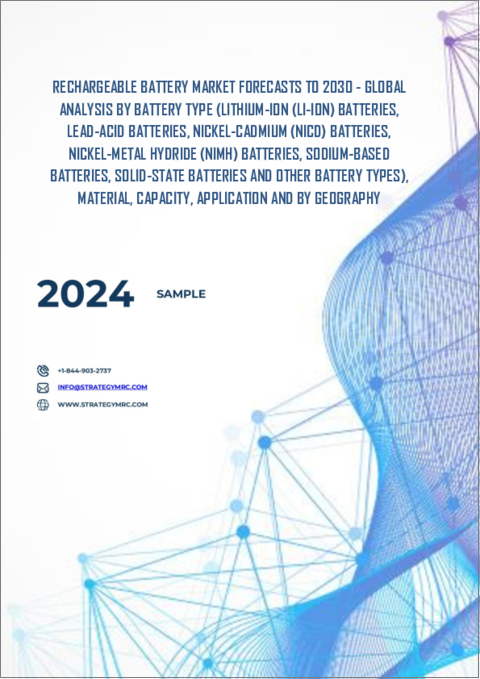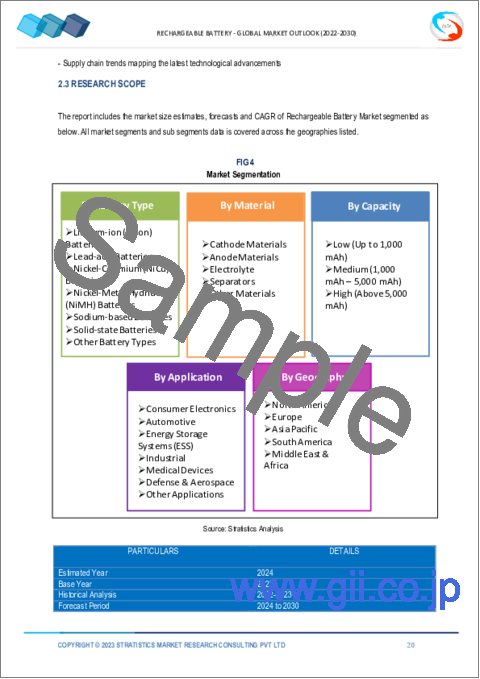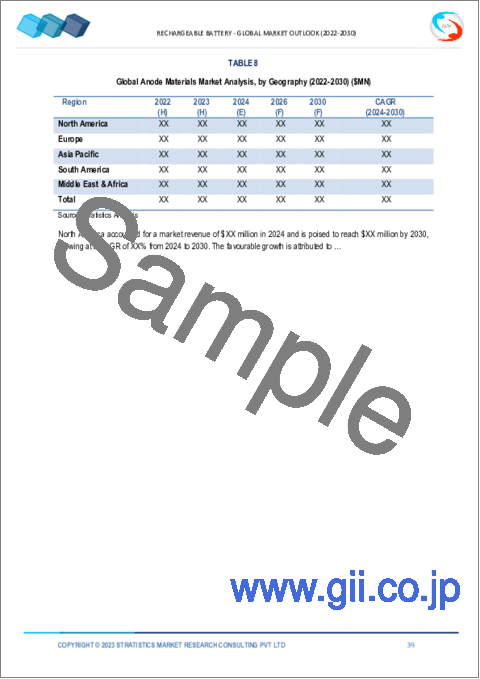|
|
市場調査レポート
商品コード
1569748
二次電池市場の2030年までの予測:電池タイプ、材料、容量、用途、地域別の世界分析Rechargeable Battery Market Forecasts to 2030 - Global Analysis By Battery Type, Material, Capacity, Application and By Geography |
||||||
カスタマイズ可能
|
|||||||
| 二次電池市場の2030年までの予測:電池タイプ、材料、容量、用途、地域別の世界分析 |
|
出版日: 2024年10月10日
発行: Stratistics Market Research Consulting
ページ情報: 英文 200+ Pages
納期: 2~3営業日
|
- 全表示
- 概要
- 図表
- 目次
Stratistics MRCによると、世界の二次電池市場は2024年に942億8,000万米ドルを占め、2030年には1,524億3,000万米ドルに達すると予測され、予測期間中のCAGRは6.2%です。
二次電池は、エネルギーが枯渇した後に充電することで何度も使用できるエネルギー貯蔵装置の一種です。二次電池は、可逆的な化学反応によって電気エネルギーを蓄えます。充電して再利用できるため、廃棄物を減らし、長期的な費用対効果を実現できることから、家電製品、電気自動車、再生可能エネルギーシステムなど、さまざまな用途で広く使われています。
国際エネルギー機関(IEA)によると、自動車分野でのリチウムイオン電池の需要は2022年に約65%増加しました。
再生可能エネルギーの採用増加
太陽光発電や風力発電は断続的であるため、二次電池は余剰エネルギーを貯蔵して後で使用し、安定した電力供給を確保するために不可欠です。二次電池は、グリッド規模の蓄電システム、住宅用エネルギー・ソリューション、電気自動車に使用されています。さらに、再生可能エネルギーへのシフトは、より高い効率とより長いライフサイクルを提供するリチウムイオン電池や固体電池などの高度な電池技術の開発を加速させ、市場の成長をさらに促進しています。
限られたリサイクルインフラ
二次電池のリサイクルインフラが限られているのは、リチウム、コバルト、ニッケルなどの危険物質を含む電池の組成が複雑で、安全にリサイクルするには特殊なプロセスが必要なことに起因しています。さらに、一貫性のない規制と高いリサイクルコストが大規模施設への投資を抑制しています。このような適切なリサイクルシステムの不足は、環境問題への懸念の増大、規制圧力、サプライチェーンの混乱によって市場の成長を妨げます。
携帯用電子機器の需要増加
携帯電子機器には効率的で長持ちする電源が必要であり、エネルギー密度が高く寿命が長いリチウムイオンのような二次電池が選ばれています。民生用電子機器がより高度になり、電力を大量に消費するようになると、信頼性の高いエネルギー貯蔵ソリューションの必要性が高まる。さらに、ワイヤレスでコンパクトなデバイスの動向は、二次電池の需要をさらに押し上げ、メーカーが進化するエネルギー要件に対応するために技術革新を進めるにつれて、市場の拡大につながります。
原材料供給の制約
二次電池における原材料供給の制約は、リチウム、コバルト、ニッケルなどの主要材料の入手が限られていることに起因します。これらの元素は電池生産に不可欠であるにもかかわらず、供給が数カ国に集中しているため、地政学的リスク、採掘の課題、環境への懸念につながっています。このような供給問題は、生産コストを引き上げ、製造を遅らせ、電池技術の拡張性を制限するため、市場全体の成長を妨げます。
COVID-19の影響
COVID-19の大流行は、サプライチェーンの中断、生産量の減少、物流の課題を通じて二次電池市場を混乱させました。しかし、遠隔地勤務へのシフトや携帯電子機器への依存の高まりも加速させ、電池需要を押し上げました。この危機は、より強靭なサプライチェーンの必要性を浮き彫りにし、電池技術の革新に火をつけた。パンデミック後の回復では、電気自動車や再生可能エネルギー・ソリューションの採用拡大が需要を回復させています。
予測期間中、鉛蓄電池分野が最大になる見込み
予測期間中、鉛蓄電池分野が最大のシェアを占めると予測されます。鉛蓄電池は定評のあるエネルギー貯蔵技術であり、自動車、産業、バックアップ電源用途で一般的に使用されています。これらの電池は、鉛ベースの電極と電解液としての硫酸で構成され、信頼性の高い性能、費用対効果、耐久性を提供します。自動車、再生可能エネルギー・システム、重要システム用無停電電源装置(UPS)などに広く使用されています。
予測期間中、自動車分野が最も高いCAGRが見込まれる
自動車分野は予測期間中、最も高いCAGRが見込まれます。二次電池は、自動車用途、特に電気自動車(EV)、ハイブリッド車、プラグインハイブリッド車において重要な役割を果たしています。これらの電池は、よりクリーンで持続可能な輸送を可能にします。何度も充電することができるため、自動車の航続距離と性能が向上し、電池技術の革新によってエネルギー密度、充電速度、寿命が改善されます。二次電池は、排出量を削減し、自動車産業における電動モビリティへのシフトを進めるために不可欠です。
最大のシェアを占める地域
アジア太平洋地域は、家電利用の増加、電気自動車(EV)の普及拡大、再生可能エネルギー貯蔵への投資の増加により、予測期間中に最大の市場シェアを占めると予想されます。中国、日本、韓国などの主要市場は、バッテリーの生産と技術革新でリードしています。この地域の強固な製造能力は、政府の支援政策や中間層の増加と相まって、市場拡大をさらに刺激します。バッテリー技術とインフラ整備の新興国市場は、引き続き成長見通しを高めています。
CAGRが最も高い地域:
北米は、電気自動車(EV)の普及、ポータブル電子機器の需要増加、再生可能エネルギー貯蔵への投資拡大により、予測期間中に最も高いCAGRを記録すると予測されます。米国とカナダは、技術革新と製造能力を重視する主要プレーヤーです。クリーンエネルギーに対する政府の優遇措置と、リチウムイオン電池や固体電池などの電池技術の進歩が市場成長を促進しています。さらに、持続可能性とエネルギー効率に向けた動きは、この地域における二次電池の需要をさらに促進しています。
無料のカスタマイズサービス
本レポートをご購読のお客様には、以下の無料カスタマイズオプションのいずれかをご利用いただけます:
- 企業プロファイル
- 追加市場プレイヤーの包括的プロファイリング(3社まで)
- 主要企業のSWOT分析(3社まで)
- 地域セグメンテーション
- 顧客の関心に応じた主要国の市場推計・予測・CAGR(注:フィージビリティチェックによる)
- 競合ベンチマーキング
- 製品ポートフォリオ、地理的プレゼンス、戦略的提携に基づく主要企業のベンチマーキング
目次
第1章 エグゼクティブサマリー
第2章 序文
- 概要
- ステークホルダー
- 調査範囲
- 調査手法
- データマイニング
- データ分析
- データ検証
- 調査アプローチ
- 調査情報源
- 1次調査情報源
- 2次調査情報源
- 前提条件
第3章 市場動向分析
- 促進要因
- 抑制要因
- 機会
- 脅威
- 用途分析
- 新興市場
- COVID-19の影響
第4章 ポーターのファイブフォース分析
- 供給企業の交渉力
- 買い手の交渉力
- 代替品の脅威
- 新規参入業者の脅威
- 競争企業間の敵対関係
第5章 世界の二次電池市場:電池タイプ別
- リチウムイオン(Li-ion)電池
- 鉛蓄電池
- ニッケルカドミウム(NiCd)電池
- ニッケル水素(NiMH)電池
- ナトリウム系電池
- 固体電池
- その他の電池タイプ
第6章 世界の二次電池市場:材料別
- カソード材料
- アノード材料
- 電解質
- セパレータ
- その他の材料
第7章 世界の二次電池市場:容量別
- 低(1,000mAh未満)
- 中(1,000mAh-5,000mAh)
- 高(5,000mAh以上)
第8章 世界の二次電池市場:用途別
- 家電
- 自動車
- エネルギー貯蔵システム(ESS)
- 産業
- 医療機器
- 防衛・航空宇宙
- その他の用途
第9章 世界の二次電池市場:地域別
- 北米
- 米国
- カナダ
- メキシコ
- 欧州
- ドイツ
- 英国
- イタリア
- フランス
- スペイン
- その他欧州
- アジア太平洋
- 日本
- 中国
- インド
- オーストラリア
- ニュージーランド
- 韓国
- その他アジア太平洋地域
- 南米
- アルゼンチン
- ブラジル
- チリ
- その他南米
- 中東・アフリカ
- サウジアラビア
- アラブ首長国連邦
- カタール
- 南アフリカ
- その他中東とアフリカ
第10章 主な発展
- 契約、パートナーシップ、コラボレーション、合弁事業
- 買収と合併
- 新製品発売
- 事業拡大
- その他の主要戦略
第11章 企業プロファイリング
- Panasonic Corporation
- LG Chem Corporation
- Samsung Corporation
- BYD Company Limited
- Contemporary Amperex Technology Co. Limited(CATL)
- Tesla Inc.
- Sony Corporation
- A123 Systems
- GS Yuasa Corporation
- Saft Groupe S.A.
- Toshiba Corporation
- Hitachi Chemical Company
- Johnson Controls
- SK Innovation Corporation
- EnerSys
- KLVR
- Shenzhen Yongxinlong New Energy Technology Corporation
List of Tables
- Table 1 Global Rechargeable Battery Market Outlook, By Region (2022-2030) ($MN)
- Table 2 Global Rechargeable Battery Market Outlook, By Battery Type (2022-2030) ($MN)
- Table 3 Global Rechargeable Battery Market Outlook, By Lithium-ion (Li-ion) Batteries (2022-2030) ($MN)
- Table 4 Global Rechargeable Battery Market Outlook, By Lead-acid Batteries (2022-2030) ($MN)
- Table 5 Global Rechargeable Battery Market Outlook, By Nickel-Cadmium (NiCd) Batteries (2022-2030) ($MN)
- Table 6 Global Rechargeable Battery Market Outlook, By Nickel-Metal Hydride (NiMH) Batteries (2022-2030) ($MN)
- Table 7 Global Rechargeable Battery Market Outlook, By Sodium-based Batteries (2022-2030) ($MN)
- Table 8 Global Rechargeable Battery Market Outlook, By Solid-state Batteries (2022-2030) ($MN)
- Table 9 Global Rechargeable Battery Market Outlook, By Other Battery Types (2022-2030) ($MN)
- Table 10 Global Rechargeable Battery Market Outlook, By Material (2022-2030) ($MN)
- Table 11 Global Rechargeable Battery Market Outlook, By Cathode Materials (2022-2030) ($MN)
- Table 12 Global Rechargeable Battery Market Outlook, By Anode Materials (2022-2030) ($MN)
- Table 13 Global Rechargeable Battery Market Outlook, By Electrolyte (2022-2030) ($MN)
- Table 14 Global Rechargeable Battery Market Outlook, By Separators (2022-2030) ($MN)
- Table 15 Global Rechargeable Battery Market Outlook, By Other Materials (2022-2030) ($MN)
- Table 16 Global Rechargeable Battery Market Outlook, By Capacity (2022-2030) ($MN)
- Table 17 Global Rechargeable Battery Market Outlook, By Low (Up to 1,000 mAh) (2022-2030) ($MN)
- Table 18 Global Rechargeable Battery Market Outlook, By Medium (1,000 mAh - 5,000 mAh) (2022-2030) ($MN)
- Table 19 Global Rechargeable Battery Market Outlook, By High (Above 5,000 mAh) (2022-2030) ($MN)
- Table 20 Global Rechargeable Battery Market Outlook, By Application (2022-2030) ($MN)
- Table 21 Global Rechargeable Battery Market Outlook, By Consumer Electronics (2022-2030) ($MN)
- Table 22 Global Rechargeable Battery Market Outlook, By Automotive (2022-2030) ($MN)
- Table 23 Global Rechargeable Battery Market Outlook, By Energy Storage Systems (ESS) (2022-2030) ($MN)
- Table 24 Global Rechargeable Battery Market Outlook, By Industrial (2022-2030) ($MN)
- Table 25 Global Rechargeable Battery Market Outlook, By Medical Devices (2022-2030) ($MN)
- Table 26 Global Rechargeable Battery Market Outlook, By Defense & Aerospace (2022-2030) ($MN)
- Table 27 Global Rechargeable Battery Market Outlook, By Other Applications (2022-2030) ($MN)
Note: Tables for North America, Europe, APAC, South America, and Middle East & Africa Regions are also represented in the same manner as above.
According to Stratistics MRC, the Global Rechargeable Battery Market is accounted for $94.28 billion in 2024 and is expected to reach $152.43 billion by 2030 growing at a CAGR of 6.2% during the forecast period. A rechargeable battery is a type of energy storage device that can be used multiple times by recharging it after its energy is depleted. Rechargeable batteries store electrical energy through reversible chemical reactions. They are widely used in various applications such as consumer electronics, electric vehicles, and renewable energy systems due to their ability to be recharged and reused, thus reducing waste and offering cost-effectiveness over time.
According to International Energy Agency, the demand for lithium-ion batteries in the automotive sector grew by about 65% in 2022.
Market Dynamics:
Driver:
Rising adoption of renewable energy
As solar and wind power generation are intermittent, rechargeable batteries are essential to store excess energy for later use, ensuring a stable power supply. They are used in grid-scale storage systems, residential energy solutions, and electric vehicles. Additionally, the shift toward renewable energy has accelerated the development of advanced battery technologies, such as lithium-ion and solid-state batteries, which offer higher efficiency and longer life cycles, further propelling market growth.
Restraint:
Limited recycling infrastructure
The limited recycling infrastructure for rechargeable batteries stems from the complexity of battery composition, involving hazardous materials like lithium, cobalt, and nickel, which require specialized processes to safely recycle. Additionally, inconsistent regulations and high recycling costs discourage investment in large-scale facilities. This shortage of proper recycling systems hampers market growth by increasing environmental concerns, regulatory pressures, and supply chain disruptions.
Opportunity:
Increasing demand for portable electronics
Portable electronics require efficient, long-lasting power sources, making rechargeable batteries like lithium-ion the preferred choice due to their high energy density and extended lifespan. As consumer electronics become more advanced and power-intensive, the need for reliable energy storage solutions rises. Additionally, the growing trend of wireless and compact devices further boosts the demand for rechargeable batteries, leading to market expansion as manufacturers innovate to meet evolving energy requirements.
Threat:
Raw material supply constraints
Raw material supply constraints in the rechargeable battery arise due to limited availability of key materials like lithium, cobalt, and nickel. These elements are critical for battery production, yet their supply is concentrated in a few countries, leading to geopolitical risks, mining challenges, and environmental concerns. These supply issues raise production costs, slow down manufacturing, and limit the scalability of battery technologies, thus hampering overall market growth.
Covid-19 Impact
The covid-19 pandemic disrupted the rechargeable battery market through supply chain interruptions, reduced manufacturing output, and logistical challenges. However, it also accelerated the shift towards remote work and increased reliance on portable electronics, boosting battery demand. The crisis highlighted the need for more resilient supply chains and sparked innovation in battery technology. Post-pandemic recovery has seen a rebound in demand, driven by the growing adoption of electric vehicles and renewable energy solutions.
The lead-acid batteries segment is expected to be the largest during the forecast period
The lead-acid batteries segment is estimated to be the largest share during the forecast period. Lead-acid rechargeable batteries are a well-established energy storage technology, commonly used in automotive, industrial, and backup power applications. These batteries consist of lead-based electrodes and sulfuric acid as an electrolyte, offering reliable performance, cost-effectiveness, and durability. They are widely used in vehicles, renewable energy systems, and uninterruptible power supplies (UPS) for critical systems.
The automotive segment is expected to have the highest CAGR during the forecast period
The automotive segment is anticipated to witness the highest CAGR during the forecast period. Rechargeable batteries play a crucial role in automotive applications, particularly in electric vehicles (EVs), hybrids, and plug-in hybrids. These batteries enables cleaner and more sustainable transportation. Their ability to be recharged multiple times extends vehicle range and performance, while innovations in battery technology improve energy density, charging speed, and lifespan. Rechargeable batteries are vital for reducing emissions and advancing the shift towards electric mobility in the automotive industry.
Region with largest share:
Asia Pacific is expected to have the largest market share during the forecast period due to increasing consumer electronics usage, expanding electric vehicle (EV) adoption, and growing investments in renewable energy storage. Key markets such as China, Japan, and South Korea are leading in battery production and technology innovation. The region's robust manufacturing capabilities, coupled with supportive government policies and a rising middle class, further stimulate market expansion. Advancements in battery technology and infrastructure development continue to enhance the market's growth prospects.
Region with highest CAGR:
North America is projected to witness the highest CAGR over the forecast period, owing to ising adoption of electric vehicles (EVs), increasing demand for portable electronics, and growing investments in renewable energy storage. The United States and Canada are key players, with strong emphasis on technological innovation and manufacturing capabilities. Government incentives for clean energy and advancements in battery technologies, such as lithium-ion and solid-state batteries, are driving market growth. Additionally, the push towards sustainability and energy efficiency further fuels the demand for rechargeable batteries in the region.
Key players in the market
Some of the key players profiled in the Rechargeable Battery Market include Panasonic Corporation, LG Chem Corporation, Samsung Corporation, BYD Company Limited, Contemporary Amperex Technology Co. Limited (CATL), Tesla Inc., Sony Corporation, A123 Systems, GS Yuasa Corporation, Saft Groupe S.A., Toshiba Corporation, Hitachi Chemical Company, Johnson Controls, SK Innovation Corporation, EnerSys, KLVR and Shenzhen Yongxinlong New Energy Technology Corporation.
Key Developments:
In August 2024, KLVR has introduced a new rechargeable battery solution aimed at reducing the use of single-use batteries in media production and live performance industries. Their Charger Pro offers a "cost-effective, flexible solution" for recharging standard AA and AAA batteries used in wireless microphones, in-ear monitors and other professional audio devices. The system is designed to meet the specific power needs of professional environments where reliability is critical.
In April 2024, Shenzhen Yongxinlong New Energy Technology has launched lithium-ion rechargeable batteries for electric vehicles. It possesses high-rate discharge performance, as the capacity means the discharge capacity of the cell, which is measured with a discharge current of 0.2 C with a 2.5V cut-off voltage after standard charge. The cell shall be charged in accordance with the standard charging method. The cell shall be stored at a temperature of 55 +/- 2 °C for 7 days.
Battery Types Covered:
- Lithium-ion (Li-ion) Batteries
- Lead-acid Batteries
- Nickel-Cadmium (NiCd) Batteries
- Nickel-Metal Hydride (NiMH) Batteries
- Sodium-based Batteries
- Solid-state Batteries
- Other Battery Types
Materials Covered:
- Cathode Materials
- Anode Materials
- Electrolyte
- Separators
- Other Materials
Capacities Covered:
- Low (Up to 1,000 mAh)
- Medium (1,000 mAh - 5,000 mAh)
- High (Above 5,000 mAh)
Applications Covered:
- Consumer Electronics
- Automotive
- Energy Storage Systems (ESS)
- Industrial
- Medical Devices
- Defense & Aerospace
- Other Applications
Regions Covered:
- North America
- US
- Canada
- Mexico
- Europe
- Germany
- UK
- Italy
- France
- Spain
- Rest of Europe
- Asia Pacific
- Japan
- China
- India
- Australia
- New Zealand
- South Korea
- Rest of Asia Pacific
- South America
- Argentina
- Brazil
- Chile
- Rest of South America
- Middle East & Africa
- Saudi Arabia
- UAE
- Qatar
- South Africa
- Rest of Middle East & Africa
What our report offers:
- Market share assessments for the regional and country-level segments
- Strategic recommendations for the new entrants
- Covers Market data for the years 2022, 2023, 2024, 2026, and 2030
- Market Trends (Drivers, Constraints, Opportunities, Threats, Challenges, Investment Opportunities, and recommendations)
- Strategic recommendations in key business segments based on the market estimations
- Competitive landscaping mapping the key common trends
- Company profiling with detailed strategies, financials, and recent developments
- Supply chain trends mapping the latest technological advancements
Free Customization Offerings:
All the customers of this report will be entitled to receive one of the following free customization options:
- Company Profiling
- Comprehensive profiling of additional market players (up to 3)
- SWOT Analysis of key players (up to 3)
- Regional Segmentation
- Market estimations, Forecasts and CAGR of any prominent country as per the client's interest (Note: Depends on feasibility check)
- Competitive Benchmarking
- Benchmarking of key players based on product portfolio, geographical presence, and strategic alliances
Table of Contents
1 Executive Summary
2 Preface
- 2.1 Abstract
- 2.2 Stake Holders
- 2.3 Research Scope
- 2.4 Research Methodology
- 2.4.1 Data Mining
- 2.4.2 Data Analysis
- 2.4.3 Data Validation
- 2.4.4 Research Approach
- 2.5 Research Sources
- 2.5.1 Primary Research Sources
- 2.5.2 Secondary Research Sources
- 2.5.3 Assumptions
3 Market Trend Analysis
- 3.1 Introduction
- 3.2 Drivers
- 3.3 Restraints
- 3.4 Opportunities
- 3.5 Threats
- 3.6 Application Analysis
- 3.7 Emerging Markets
- 3.8 Impact of Covid-19
4 Porters Five Force Analysis
- 4.1 Bargaining power of suppliers
- 4.2 Bargaining power of buyers
- 4.3 Threat of substitutes
- 4.4 Threat of new entrants
- 4.5 Competitive rivalry
5 Global Rechargeable Battery Market, By Battery Type
- 5.1 Introduction
- 5.2 Lithium-ion (Li-ion) Batteries
- 5.3 Lead-acid Batteries
- 5.4 Nickel-Cadmium (NiCd) Batteries
- 5.5 Nickel-Metal Hydride (NiMH) Batteries
- 5.6 Sodium-based Batteries
- 5.7 Solid-state Batteries
- 5.8 Other Battery Types
6 Global Rechargeable Battery Market, By Material
- 6.1 Introduction
- 6.2 Cathode Materials
- 6.3 Anode Materials
- 6.4 Electrolyte
- 6.5 Separators
- 6.6 Other Materials
7 Global Rechargeable Battery Market, By Capacity
- 7.1 Introduction
- 7.2 Low (Up to 1,000 mAh)
- 7.3 Medium (1,000 mAh - 5,000 mAh)
- 7.4 High (Above 5,000 mAh)
8 Global Rechargeable Battery Market, By Application
- 8.1 Introduction
- 8.2 Consumer Electronics
- 8.3 Automotive
- 8.4 Energy Storage Systems (ESS)
- 8.5 Industrial
- 8.6 Medical Devices
- 8.7 Defense & Aerospace
- 8.8 Other Applications
9 Global Rechargeable Battery Market, By Geography
- 9.1 Introduction
- 9.2 North America
- 9.2.1 US
- 9.2.2 Canada
- 9.2.3 Mexico
- 9.3 Europe
- 9.3.1 Germany
- 9.3.2 UK
- 9.3.3 Italy
- 9.3.4 France
- 9.3.5 Spain
- 9.3.6 Rest of Europe
- 9.4 Asia Pacific
- 9.4.1 Japan
- 9.4.2 China
- 9.4.3 India
- 9.4.4 Australia
- 9.4.5 New Zealand
- 9.4.6 South Korea
- 9.4.7 Rest of Asia Pacific
- 9.5 South America
- 9.5.1 Argentina
- 9.5.2 Brazil
- 9.5.3 Chile
- 9.5.4 Rest of South America
- 9.6 Middle East & Africa
- 9.6.1 Saudi Arabia
- 9.6.2 UAE
- 9.6.3 Qatar
- 9.6.4 South Africa
- 9.6.5 Rest of Middle East & Africa
10 Key Developments
- 10.1 Agreements, Partnerships, Collaborations and Joint Ventures
- 10.2 Acquisitions & Mergers
- 10.3 New Product Launch
- 10.4 Expansions
- 10.5 Other Key Strategies
11 Company Profiling
- 11.1 Panasonic Corporation
- 11.2 LG Chem Corporation
- 11.3 Samsung Corporation
- 11.4 BYD Company Limited
- 11.5 Contemporary Amperex Technology Co. Limited (CATL)
- 11.6 Tesla Inc.
- 11.7 Sony Corporation
- 11.8 A123 Systems
- 11.9 GS Yuasa Corporation
- 11.10 Saft Groupe S.A.
- 11.11 Toshiba Corporation
- 11.12 Hitachi Chemical Company
- 11.13 Johnson Controls
- 11.14 SK Innovation Corporation
- 11.15 EnerSys
- 11.16 KLVR
- 11.17 Shenzhen Yongxinlong New Energy Technology Corporation






